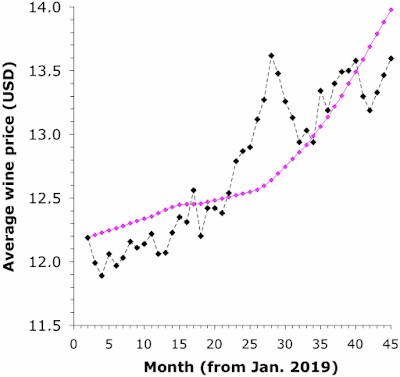Things have, of course, changed since those days, particularly decreases; and I will look at some of those changes here.
I will be talking about wine in the USA, but as a quick aside, it has also been reported that over recent decades there has been a “seemingly perpetual decline in consumption of France’s national drink” (Why are the French drinking less wine?). The industry has its ups and downs, but in France it seems to be slowly but continually down.
Actually, the part of the French wine industry going “down” is what they call “country wine”, the inexpensive everyday (literally, in France) tipple consumed when relaxing. * That is not far from what is currently being reported in the USA, as well, where it is the bottom of the market that is having a hard time, currently.
There has been the expectation that Robert M. Parker Jr has previously been the prime force behind wine preferences in the USA (What Are Americans drinking?). However, that has been slowly changing, with “increased social conscious consumer demand for products tied to non and low-alc., sustainability, and organic” (Beverage alcohol buying trends reflective of growing consumer consciousness). More importantly, though, Americans are drinking less alcohol, in general (Americans are consuming fewer AlcBev drinks per week), and price has come to the fore (2/3 of consumers cutting back on BevAlc purchases because of inflation). Indeed, we are even told that: Financial constraints blunt consumers support for sustainability.
So, it seems to be inflation that is the current issue — wine prices are going up, but our incomes are not. However, if we look at this point with respect to wine, it is not always true that wine prices are determined solely by inflation (Why wine is actually cheaper after inflation). Here is a graph based on data from the U.S. Bureau of Labor Statistics (via Mashed). It refers to the average cost, per month, of: “Wine, red and white table, all sizes, any origin, per 1 liter (33.8 oz.)” (Data Series ID: 720311).
The data start (horizontally) at the beginning of 2019, and run monthly until the present. The black points represent the actual price (vertically). The pink points are the increase in price calculated based on the reported monthly inflation (from US Inflation Rate ). So, when the pink line is above the black line, then US wine has not increased in price as fast as inflation would suggest; and when the pink line is below the black line, then wine has gone up in price faster than we would expect from inflation alone.
As you can see, both situations have occurred in the past few years. Up until October 2020, Americans were doing well (average wine price stayed below inflation), but then things went really bad. The pandemic started in January 2020, but by October its effects had really settled in; and things stayed that way for a year, as wine prices peaked. However, for the next half-year, things were pretty much as we would have forecast way back at the beginning of 2019 (wine price = inflation price). Since April, prices have dropped and then risen again — and it is the increase over the past 4 months that the current media discussion is all about, as wine prices are now as high as they have ever been.
The basic issue here is that not all effects on wine price are reflected by inflation. For example, there are currently: “supply-side shortages of crucial ingredients and packaging materials, lower yields of raw materials brought on by summer droughts, and skyrocketing energy costs” (Alcohol beverage industry facing “unprecedented” challenges but remains resilient). Both the pandemic and the war in the Ukraine are usually fingered as the prime causes of disruptions, while drought is a particular problem in the USA. **
So, where does that leave us? Well, current US wine prices are actually less than we would have forecast 3 years ago, given the US inflation rate since then. That, however, does not make the wallets of American wine drinkers feel any better. So, it has been noted that the U.S. table wine market remains sluggish, but above $15 brands thrive. In other words, it is the cheap stuff that is suffering:
As the on-premise sector continues its slow but steady recovery from the pandemic, the U.S. wine market is expected to eke out another gain in dollar terms in 2022, but volumes will fall for the second consecutive year.Interestingly, it seems that the extreme upper end is actually doing very well: Inflation shelter? Super-premium is the place to be. As a pensioner, I don’t really need an inflation shelter, but I really could do without inflation eating away at my pension. Wisely, I have stashed away some wine over the years, and so I can continue to drink well for the foreseeable future (but not super-premium).
* You should check out this old advice: No more than a litre of wine a day, recommends a 1950s French sobriety poster.
** The Ukraine war, for example, has had a dramatic effect on European Union energy costs, and particularly in the United Kingdom. Here in Sweden, electricity prices recently peaked at 3.5x last year's prices.




No comments:
Post a Comment